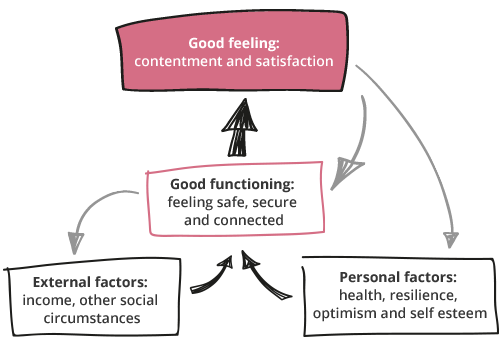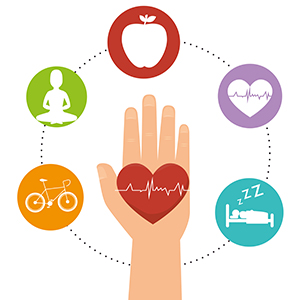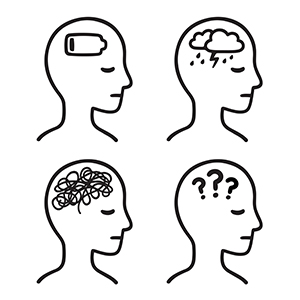We will also help you to understand more about the value of social support, sleep, diet and exercise and how these can protect our wellbeing. Finally, we will explore the treatment options that are available to us if we become unwell, learning more about the different types of therapy that are available.

What is wellbeing?
Mental health and wellbeing are terms that are commonly used in everyday language. However, research shows that wellbeing can mean different things to different people. For example, when we asked Open University students to sum up what wellbeing meant to them, some used words such as ‘contentment’, ‘calmness’ and ‘happiness’ that indicated they thought wellbeing was focused on aspects of mental health. However, other students provided words that showed they thought wellbeing was living a life ‘free from illness’ and other terms focused on physical aspects of health. Most academics now accept that mental health and physical wellbeing are intertwined. For example, the definition of mental health used by the World Health Organization (WHO) relies on a broad concept of 'wellbeing':
A state of wellbeing in which every individual realizes his or her own potential, can cope with the normal stresses of life, can work productively and fruitfully and is able to make a contribution to her or his community. It is a state of complete physical, mental and social wellbeing and not merely the absence of disease or infirmity.
While this definition has been praised, there has also been some criticism of the overly positive nature of the definition. For example, some academics suggest that the focus on a complete state of wellbeing is not always helpful, suggesting that many people who are in good mental health often experience emotions such as sadness and anger (Galderisi et al, 2015). They go further in pointing out that because we do not have complete mastery over our environment, or control over what happens to us, it is impossible to achieve a purely positive mood. Instead, expressing negative emotions in response to challenging life situations is perfectly mentally healthy.
Measuring wellbeing
Given the varied ways in which we understand and think about our personal wellbeing, you might think that it would be difficult to quantify, or to put it another way, to put a number on our sense of wellbeing. You would not be alone, some people do think it is difficult or even impossible to measure something like wellbeing. However, in the UK the Office for National Statistics measures personal wellbeing in the population. In brief, they measure personal wellbeing by dividing it into four sections, each of which can affect an individual’s overall wellbeing:
- Their satisfaction with life overall
- The feeling that the things they do are worthwhile
- Their levels of happiness
- Their levels of anxiety
For the purposes of monitoring the wellbeing of the nation, this is then used to produce an overall wellness rating. These methods rely on standardised ways of assessing the impact or contribution each of these factors makes towards an overall feeling of wellbeing. In doing so, the researchers make assumptions and estimates. In the real world, the way in which each of these factors affects someone’s wellbeing will vary depending on the individual who is experiencing them. For example, some people will be more affected by one factor than another person. i.e. one person may find doing meaningful activities is more important to them than their overall feelings of happiness.
These standardised ways of calculating wellbeing have both advantages and disadvantages. However, one of the things that statistics can help us explore are some of the commonly held myths that exist around mental health. For example, it was once commonly assumed that only people with mental health problems experience changes in their mood and sense of wellbeing. We now understand that it is quite common for most people to experience some changes in their sense of wellbeing and mood. Data from the ONS shows that in the UK around on average people gave a score of 7.8 out of 10 for the happiness index. While the same research also showed that on average anxiety scores in the same population were 3.2 out of 10. You can search for how people in your post-code area felt by using the Personal well-being interactive maps.

What kind of factors affect our mental health and wellbeing?
Many different things can affect our mental health and wellbeing. It is normal to feel different levels of wellbeing at different times in our lives and in accordance with the things that are happening around us. Accepting that mental health and wellbeing are influenced by factors around us is important and often under-acknowledged fact.
To understand what affects a person’s wellbeing, you need to think about their individual circumstances. For example, an individual’s external circumstances (income, employment status, housing and social circumstances) in combination with their personal resources (health, sense of resilience and optimism) allow them to experience a feeling of wellbeing. One such example can be seen in the model below in Figure 1, the dynamic model of wellbeing.

This model has been adapted from a report called Measuring Wellbeing by The New Economic Foundation. It shows how different aspects of our wellbeing connect with each other and how improvements in one area can influence other parts of an individual’s experiences. While we often think of wellbeing as being a personal issue that relates to our individual mood and coping skills, even people who have a great deal of personal resilience and who are mostly content in life can have their sense of wellbeing affected by external things that happen to them.
Social support, sleep and sustenance
As well as these natural fluctuations, different circumstances, such as physical illness, stress levels at work, or financial issues, will affect our emotional state. Many of these things are outside of our control. However, it is important to remember there are some factors within our control that can impact significantly on our wellbeing. One of the most essential factors for our mental wellbeing is sleep. Sleep and wellbeing are strongly related, it is as important to our sense of wellbeing as other forms of sustenance such as good and water. While we are all aware of the value of a good nights sleep, we may not appreciate that that changes in our lives can cause profound psychological strain and mean our tiredness and need for sleep can increase. You may find it useful to try relaxation apps such as Calm if you are struggling to sleep. The Sleep Council also provide advice with seven steps to a better night’s sleep.

One factor which has gained increasing attention is diet with new research suggesting that imbalances in our gut bacteria can have an impact on our mental health. Mind have created a video to help you consider the impact of food and your mood which you can watch below. Changes to your diet may feel daunting at first but remember eating well does not have to complicated or expensive, consider these tips on how to eat well for less.
Finally, one of the things we often undervalue is the importance of relationships to our sense of wellbeing. We know that people who have plenty of contact with others often experience a better quality of life than those with few social contacts.
Loneliness, on the other hand, is a natural phenomenon and most people will feel lonely at some point in time. You can feel lonely even when you are surrounded by people. General life transitions are key moments that result in people feeling lonely such as leaving home, starting a new job, retirement or divorce. Many other life commitments can result in loneliness too such as illness, caring responsibilities or bereavement.
Although risk of feeling lonely can increase with age, Dr Deborah Morgan discusses how loneliness can be felt by anybody at any time and how we can alleviate loneliness.
Like Brian’s story in Dr Morgan’s talk, individuals may also experience social isolation which is defined as the absence of contact with other people. Rurality, lack of support services or transport in your local area can result in social isolation and limited opportunities to make connections. Just being aware of loneliness and social isolation triggers can help to take action to prevent feeling lonely and further affects to your wellbeing.
Inter-generational connections are important to overcome loneliness. Engaging with people based on interest, rather than by age groups, can help build quality relationships. Doing something you enjoy can also be very rewarding. Learning a new skill or engaging in education can help, you may want to further explore OpenLearn, FutureLearn or organisations like Men’s Sheds Cymru. For further support, Ageing Well in Wales have developed a pocket guide to help with loneliness. Although this is aimed at older people, the advice is universal in helping with feelings of loneliness and making connections.
Mental health problems
This article has focused on feelings of wellbeing and has explored some of the ways in which our physical and mental wellbeing interact. It is important to be aware that in the same way that we can talk about having ‘physical health’ we also should be aware that we have ‘mental health’. Often when we talk about mental health, we can think about it as the issues that can develop when things go wrong. What we are often really referring to is better described by the term ‘mental health problems’.
These types of issue can be more hidden from view and in some cases may be deliberately concealed because people worry about the stigma they may experience. As has already been alluded to, mental health fluctuates from time to time and varies along a scale so that it can be hard to tell when someone is having mental health problem. But when considering mental ill health, it can be helpful to think back to the WHO definition at the start of this article. This defines it as a state of wellbeing in which every individual realises his or her own potential, can cope with the normal stresses of life, can work productively.
In broad terms, a person can be deemed to have a mental health problem when they are not coping with their day-to-day lives and are unable to work or achieve their potential. It is often friends and family members who recognise that something is wrong. They might see that their relative is not functioning or coping with the ordinary demands of everyday life. This can present itself in a variety of ways, for example poor appetite, trouble sleeping, or loss of interest in usual hobbies. However, the diagnosis of a mental health problem is dependent on the identification of signs and symptoms being recognised as ‘unhealthy’ by medical practitioners.

Mental health treatment
Mental health problems are different for different people. For example, considering depression, some people may have just one episode, others experience it intermittently, and for some it is a constant presence. While professional help might be needed it is also possible, in some cases of depression, to make a change which will improve the individual’s reactions to their distress and recover their wellbeing. Both self-care (talking to friends, healthy diet, regular exercise, community activities etc.) and formal care (psychotherapy, antidepressants) are effective treatments of mental ill health.
Psychotherapy is a broad term for a whole range of practices called counselling or talking therapies. They are all conducted by different types of psychotherapists. A psychotherapist may be a psychiatrist, psychologist or other mental health professional, who has had further specialist training in psychotherapy. There are many different types of psychotherapy. They are also sometimes called talking therapies and include:
- Cognitive behavioural therapies
- Psychoanalytic therapies
- Psychodynamic therapies
- Systemic and family psychotherapy
- Arts and play therapies
- Humanistic and integrative psychotherapies
All of these talking therapies are designed to help people to overcome stress, emotional and relationship problems or troublesome habits. Different therapies are used for different types of problems. Depending on the nature of the issues therapy can also take place with individuals, groups, couples and families. It is therefore important to remember that if you try one type of therapy and find it doesn't work, then there are others that might be more effective. You can use the British Association for Counselling and Psychotherapy website to find a directory of different psychotherapists in your area. Or the British Psychological Society directory to find a psychologist.
Conclusion
One of the most important things you can take away from this is that it is important to remember that there is no single factor that influences wellbeing - wellbeing is the result of the combination of many different aspects of an individual’s life all interacting with each other.
Our mental wellbeing is not fixed and may change over time as our circumstances change. The idea that mental health can look different for different people is also important. Mental health can take many different forms. It will vary according to the things we experience, the things that happen to us can affect us both positively and negatively. It is important to acknowledge that our lives are sometimes affected by a range of external factors, some of which we only have limited control over, but all of which can impact on our wellbeing and mental health.
Crucially, we can all experience periods of sadness or feelings of anxiety, as well as feelings of happiness or excitement. Acknowledging that our mood changes and knowing what is normal for us personally is important. As is making sure we recognise those things we each need to do to take care of our mental health to ensure that we stay well.
If you need further advice on accessing support for your mental health you can find out more about national and local services here.
This resource is part of the 'Wellbeing and Mental Health Collection' created by the Open University in Wales. You can learn more and find courses, articles and other activities on the collection's homepage.






Rate and Review
Rate this article
Review this article
Log into OpenLearn to leave reviews and join in the conversation.
Article reviews